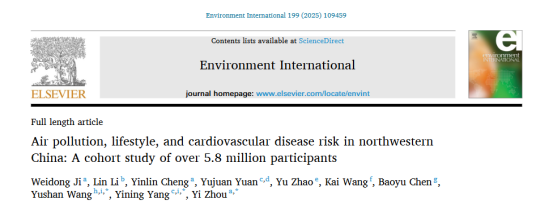Professor Zhou Yi and Professor Yang Yining's team reveal the synergistic impact of air pollution and lifestyle on cardiovascular disease based on large-scale population data
Despite continuous advancements in treatment and prevention, cardiovascular disease (CVD) remains a major global challenge. In 2023, approximately 18 million people worldwide died from CVD, accounting for 32% of total deaths. It is projected that by 2050, the number of CVD-related deaths will increase to 35.6 million, highlighting the urgent need for effective interventions to reduce its burden. The pathogenesis of CVD is complex, involving multiple factors such as genetics, environment, and lifestyle. As an important environmental risk factor, air pollution has been proven to be closely related to the incidence and mortality of CVD. However, existing studies have mainly focused on areas with relatively light traffic and industrial pollution, with fewer studies in regions significantly affected by natural sandstorms. In addition, lifestyle has a significant impact on CVD risk, and a healthy lifestyle may alleviate the adverse effects of air pollution to a certain extent. Although some studies have explored the relationship between air pollution, lifestyle, and CVD, research on the combined effect of multiple lifestyle factors and in the context of different regional pollution sources is still insufficient. Therefore, further research on the interaction between air pollution and lifestyle on CVD risk is very necessary. Recently, a joint team led by Professor Zhou Yi from Sun Yat-sen University and Professor Yang Yining from the People's Hospital of Xinjiang Uygur Autonomous Region published a research paper entitled Air pollution, lifestyle, and cardiovascular disease risk in northwestern China: A cohort study of over 5.8 million participants in the top-tier journal Environment International (Impact Factor: 10.3).

Based on ultra-large-scale cohort data of over 5.8 million participants, this study systematically evaluated the independent and combined effects of five air pollutants (PM₁, PM₂.₅, PM₁₀, O₃, CO) and lifestyle on CVD risk. The study found that both air pollution and unhealthy lifestyles significantly increase CVD risk, and the harmful effects of air pollution are particularly prominent in people with unhealthy lifestyles. More importantly, the study further revealed that there is a significant synergistic interaction between air pollution and unhealthy lifestyles, and their combined effect increases CVD risk. This finding provides new evidence for the interaction between environmental and behavioral factors in the pathogenesis of CVD.
The innovation and significance of this study are particularly prominent. It is the first time that the combined effects of multiple air pollutants and lifestyle on CVD risk have been systematically explored in regions significantly affected by natural sandstorms, filling the regional research gap in related fields. Through large-scale cohort data, the study not only confirmed that the combination of air pollution and unhealthy lifestyles has a significant synergistic effect on CVD risk but also provided a solid scientific basis for revealing the underlying interaction mechanism. This breakthrough discovery deepens our understanding of how environmental and behavioral factors jointly drive the onset of CVD, laying the foundation for formulating regionalized and personalized public health intervention strategies. More importantly, the study emphasizes the necessity of both controlling air pollution and promoting healthy lifestyles, providing important enlightenment for the implementation of precise public health policies. By combining large-scale population data with regional characteristics, this study breaks through the limitations of traditional research, provides strong scientific support for reducing the global burden of CVD, and has far-reaching academic value and practical significance.
Professor Zhou Yi from the Zhongshan School of Medicine, Sun Yat-sen University, Professor Yang Yining from the People's Hospital of Xinjiang Uygur Autonomous Region, and Wang Yushan, a postdoctoral fellow of Professor Yang Yining, are the co-corresponding authors of the paper. Ji Weidong, a doctoral student of Professor Zhou Yi in our school, is the first author. Professor Zhou Yi's team has long been engaged in research related to health care informatization and big data, medical artificial intelligence, medical large models, etc. Postdoctoral fellows and graduate students interested in this research direction are welcome to join.
Original article link: https://doi.org/10.1016/j.envint.2025.109459


